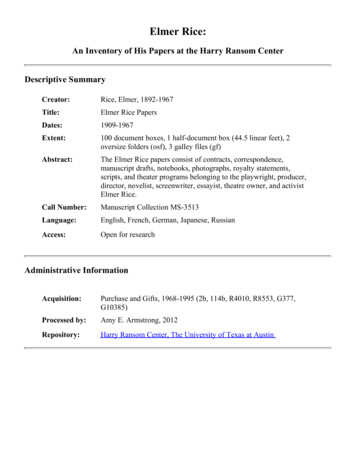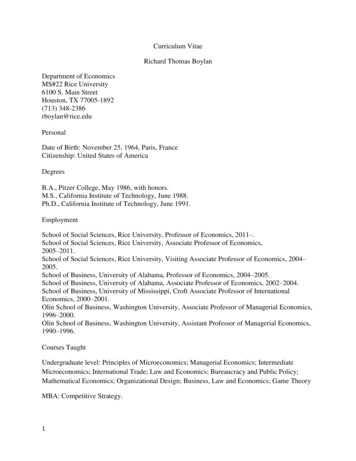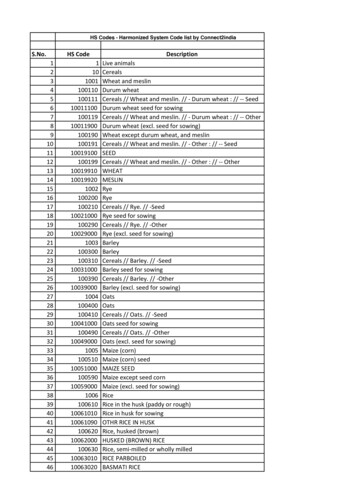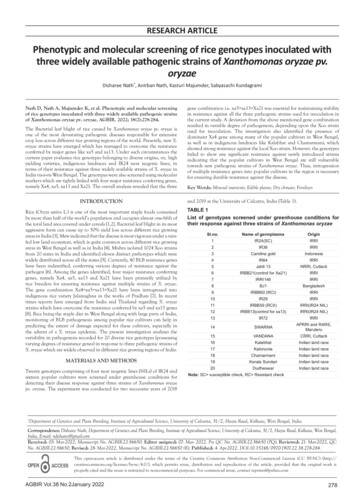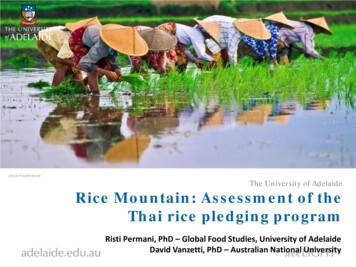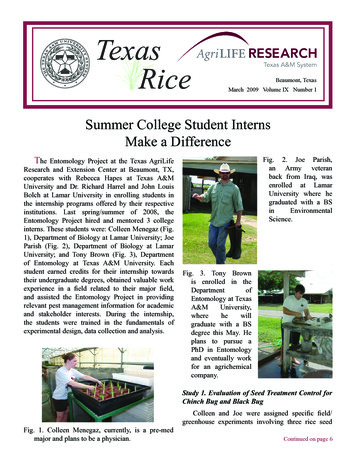
Transcription
TexasRiceBeaumont, TexasMarch 2009 Volume IX Number 1Summer College Student InternsMake a DifferenceTheEntomology Project at the Texas AgriLifeResearch and Extension Center at Beaumont, TX,cooperates with Rebecca Hapes at Texas A&MUniversity and Dr. Richard Harrel and John LouisBolch at Lamar University in enrolling students inthe internship programs offered by their respectiveinstitutions. Last spring/summer of 2008, theEntomology Project hired and mentored 3 collegeinterns. These students were: Colleen Menegaz (Fig.1), Department of Biology at Lamar University; JoeParish (Fig. 2), Department of Biology at LamarUniversity; and Tony Brown (Fig. 3), Departmentof Entomology at Texas A&M University. Eachstudent earned credits for their internship towardstheir undergraduate degrees, obtained valuable workexperience in a field related to their major field,and assisted the Entomology Project in providingrelevant pest management information for academicand stakeholder interests. During the internship,the students were trained in the fundamentals ofexperimental design, data collection and analysis.Fig. 2. Joe Parish,an Army veteranback from Iraq, wasenrolled at LamarUniversity where hegraduated with a BSinEnvironmentalScience.Fig. 3. Tony Brownis enrolled in theDepartmentofEntomology at TexasA&MUniversity,wherehewillgraduate with a BSdegree this May. Heplans to pursue aPhD in Entomologyand eventually workfor an agrichemicalcompany.Study 1. Evaluation of Seed Treatment Control forChinch Bug and Black BugColleen and Joe were assigned specific field/greenhouse experiments involving three rice seedFig. 1. Colleen Menegaz, currently, is a pre-medmajor and plans to be a physician.Continued on page
FromtheEditor .scientists located at Beaumont and Eagle Lake.Student Trainingat theBeaumont CenterWelcome to the March issue of Texas Rice. Thisbegins the 8th year of production, with three articlesincluded in this issue. In the first article, Dr. Waydescribes the summer internship program he helpeddevelop with Dr. Harrel at Lamar University andRebecca Hapes with the Texas A&M EntomologyDepartment in College Station. In 2008, Dr. Waymentored 3 students on how to conduct researchon the management of insect pests of rice. Thementoring program provided each student a glimpseof what is involved with university research. Thisexperience can be invaluable to a young adult whois in the process of deciding their career path. Dr.Way’s prominence as our country’s leading rice pestmanagement entomologist makes the experience allthat much more worthwhile. Dr. Way and our Centeralso benefit from mentoring young scientists. Theinquisitiveness, open questioning by students in thepursuit of knowledge forces our scientists to stayon their toes when designing, implementing, andmentoring each step of a student’s project.If you are interested in attending a Texasuniversity and if you are interested in participating ina summer internship program involving rice researchat Beaumont or Eagle Lake, please send an emailto one of our Center scientists letting them knowwhich areas of interest you find most fascinating.If the student and one of our scientists “click” andif the scientist has funding, there is a good chancethe student will be offered a summer position. Whoknows, it might turn out to be a once in a lifetimeexperience that influences a young person’s careerpath.The following is a list our Center’s Ph.D. level Ming Chen – Rice Cereal Chemistry and GrainQuality – ming.chen@ars.usda.gov Fugen Dou – Integrated Cropping SystemsNutrient Management – f-dou@aesrg.tamu.edu Sailaja Koti – Plant Physiology – skoti@aesrg.tamu.edu Prabodh Illukpitiya – Agricultural Economics– prabodh@aesrg.tamu.edu Xiaobao Li – Agricultural Engineering andComputer Graphics – lxb@aesrg.tamu.edu Jiale Lv – Entomology and Systems Modeling –lvjiale@aesrg.tamu.edu Garry McCauley – Agronomic, Water, and WeedManagement gmccaule@elc.net Abdul Mohammed – Plant Physiology –abdulrazack@neo.tamu.edu Shannon Pinson – Rice Genetics and MolecularBiology – shannon.pinson@ars.usda.gov Omar Samonte – Plant Genetics and VarietalDevelopment – sosamonte@aesrg.tamu.edu Dante Tabien – Plant Genetics and VarietalDevelopment – retabien@ag.tamu.edu Lee Tarpley – Whole Plant Physiology – ltarpley@ag.tamu.edu Yueguang Wang – Molecularyueguangwang@ag.tamu.edu Mo Way – Integrated Pest Management –moway@aesrg.tamu.eduBiology–Continued on page Inside This IssueCover Story: Summer College Student InternsMake a Difference2From the Editor . . . . . . . . . . . . . . . . . . . . . . . . . . . .2Instrumentation for the Study of the PhysiologicalResponse of Rice and Other Crops to GlobalWarming . . . . . . . . . . . . . . . . . . . . . . . . . . . . . .Selection of Parents for Crossing in a RiceBreeding Program Based on Phenotype . . . . . .38
Farming RiceA monthly guide for Texas growersProviding useful and timely information to Texas rice growers, so they may increaseproductivity and profitability on their farms.Instrumentation for the Study of the PhysiologicalResponse of Rice and Other Crops to Global WarmingFortemperature is well controlled [3]. The OTC requiresa high rate of ventilation to control temperature andhumidity. Many studies have reported higher daytimeand nighttime temperatures in the OTC compared tounenclosed areas [4]. The SPAR units, which aresunlit, plexiglass-enclosed environmental chambers,are one of the best in controlling the environmentalfactors. However, the cost and lack of mobility ofthese units make them site-specific. In contrast,the use of an infrared heating system does not alternatural environmental conditions, such as lightintensity, humidity and wind speed, and can be precisein controlling the set temperatures with minimalperturbation. The concept of using infrared heatingfor warming the vegetation is not a new concept andwas first used by Harte and Shaw in 1995. The useof infrared heating is appealing because it warms thevegetation similarly to normal solar heating and isenergetically efficient because it heats the vegetationdirectly. The concept of Free Air Temperature Increaseis based on infrared heating in a controlled fashion,without enclosing the plants [5].At the Texas A&M University System, AgriLifeResearch and Extension Center at Beaumont, TX,a plant physiology study was conducted to developan infrared heating system to provide controllednighttime temperatures. The heating setup thatthe study developed and used included 1) infraredheaters, 2) power controllers, 3) i-series temperaturecontrollers, 4) thermocouples, 5) thermocouple wire,6) an i-server, and 7) i-server software (Fig. 1).Most of the components were obtained from OmegaEngineering.Air temperature in the infrared heating systemsetup can be set to predetermined temperatures usingcrop scientists, the biggest challenge isto increase crop production. A 2001 report by theIntergovernmental Panel on Climate Change foundthat humanity has played an important role inglobal climate warming. Further increase in globaltemperature will decrease crop productivity peracreage, thereby increasing demand for global foodproduction. Moreover, as a result of global warming,the nighttime temperatures are predicted to increasemore than the daytime temperatures and have beenimplicated in lowering yields throughout the world[1]. Developing heat tolerant varieties throughselection and breeding programs might be one wayto maintain current crop yields and to increase futurecrop production. In order to study the effects of globalwarming, a method for applying a heating treatmentto the plant canopies, which will warm vegetation tothe desired temperatures, in the open field or in thegreenhouse is needed.Greenhouses, growth chambers, phytotrons(large walk-in growth chambers), open-top chambers(OTC), and naturally-lit plant growth chambers(known as Soil-Plant-Atmosphere-Research [SPAR]units) are the current available apparatuses to studythe effects of high nighttime temperatures and arelimited in either the ability to carefully control theelevated temperature, minimize unnatural alterationof other environmental factors, or due to extremelyhigh costs, as with SPAR units. Greenhousesgenerally have higher humidity, lower wind speedand lower light intensity compared to field conditions[2]. Moreover, it is well known that greenhousecoverings typically transmit only two-thirds tothree-fourths of the available sunlight. Similarly, inthe artificially-lit growth chambers and phytotrons,plants are subjected to artificial light; however, theContinued on next page3
Instrumentation for Global Warming Studies .heaters. Upon receiving the signal, the infraredheaters provide short intervals of slightly increasedheat output, to raise the temperature to the desiredlevel. If the temperature is above the set point asdetermined by the readings from the thermocouple,the infrared heating output is reduced for a period.In this study, the infrared heaters provided stablenighttime temperatures –the nighttime temperaturesaveraged 81.1oF at the80.6oF temperature settingand averaged 89.2oF at the89.6oF temperature setting(Fig. 2). For most of the timeof heat exposure (82%),nighttime temperature washeld within 0.9oF. Thisinfrared heating systemsuccessfully demonstratedthat it can be used instudies that evaluate plantresponses to high nighttimetemperature.Studiesthat examine the plant’sgrowth, development, andphysiology under highnighttime temperatures orscreen germplasm for heattolerance varieties willfind this infrared heatingsystem useful.Generousfundingfor the plant physiologyprojects was provided bythe Texas Rice ResearchFig. 1. Infrared heating system setup of the plant physiology project at theFoundation and the TexasBeaumont Center. The thermocouples, which attach to the i-SeriesRice Belt Warehouse. Fortemperature controllers by thermocouple wire, are type ‘T’ groundedmore information, pleasejunction probes with Teflon-insulated extensions. The i-Series temperaturecontact Dr. Tarpley atcontroller also communicates with the power controller by electrical wire409-752-2741 or emailconnections and with the i-Server through an RS-485 interface via an RJ45atltarpley@tamu.edu.serial port. The power controllers are connected to infrared heaters byFurthermore, you maystranded, insulated, nickel-plated copper wire. The i-Server communicatesconsult the followingwith the Ethernet/Internet via an RJ45 serial port. A COM port connectsreferences:the Ethernet/Internet and PC. The temperature can be set at predeterminedset points using the i-Series temperature controllers, which can be accessedfrom a remote distance through a PC via the internet and i-Server. This setup allows complex temperature regimes to be programmed.Continued on next page4i-Series temperature controllers. In this study, thenighttime temperatures were set at either a constant80.6oF (ambient) or 89.6oF (hot). When the airtemperature is below the set point as determined bythe readings from the thermocouple, a signal from thei-Series temperature controller is sent to the powercontroller, which in turn sends a signal to the infrared
Instrumentation for Global Warming Studies .[1] Houghton, J.T., Y. Ding, D.J. Griggs, M. Noguer,P.J. van der Linden, X. Dai, K. Maskell, andC.A. Johnson (Eds). 2001. Climate change 2001:the scientific basis. Contribution of WorkingGroup I of the Third Assessment Report of theIntergovernmental Panel on Climate Change, pp.555. Cambridge University Press, New York,USA.[2] Allen Jr., L.H., B.G. Drake, H.H. Rogers, and J.HShinn. 1992. Field techniques for exposure ofplants and ecosystem to elevated CO2 and othertrace gases. Critical Reviews in Plant Sciences11: 85-119.[3] Thomas, R.B., and B.R. Strain. 1991. Rootrestriction as a factor in photosynthetic acclimationof cotton seedlings growing in elevated carbondioxide. Plants Physiology 96: 627-634.global warming effects on plants in the field. PlantCell and Environment 19: 495-502. ** Article by Dr. Abdul R. Mohammed and Dr. LeeTarpley, Texas AgriLife Research and ExtensionCenter, Texas A&M System, Beaumont, TX.From the Editor . Ted Wilson – Plant Physiology, IntegratedCropping Systems Management – lt-wilson@aesrg.tamu.edu Dingchun Yan – Plant Pysiology and 3-D PlantModeling – d yan@aesrg.tamu.edu Yubin Yang – Integrated Cropping SystemManagement and Crop/Pest Modeling – yyang@[4] Adros, G., H.J. Weigel, and H.J. Jager. 1989.aesrg.tamu.eduEnvironment in open-top chambers and its effectThe second article in this issue of Texas Riceon growth and yield of plants II. Plant responses. described specialized research equipment developedGartenbauwissenschaft 54: 252-256.by Abdul Mohammed and his major professor Dr.[5] Nijs, I., F. Kockelbergh, H. Teughels, H. Blum, Tarpley to aid them in their study of whole plantG. Hendrey, and I. Impens. 1996. Free air physiology. The authors describe the equipment theytemperature increase (FATI): a new tool to study used to change the nighttime temperature of the ricecanopy. The response of rice to elevated temperaturesprovides insight into howrice responds to stress. In acompanion set of manuscriptsrecently written by Abdul andDr. Tarpley, they determine thepotential value of plant growthregulators at alleviating stresscaused by high nighttimetemperatures, thereby reducingthe negative effects of highnighttime temperature on riceyields.The third article by Drs.Samonte and Tabien and myselfprovides a general overviewof how plant breeders selectparent plants used to createnew rice varieties. Rice plantbreeding involves both narrowFig. 2. Stability of air temperatures controlled by the infrared heating systemContinued on next pagesetup at 80.6oF and 89.6oF over at least 125 days.5
From the Editor .Management Tests. Colleen, Joe and Dr. Harrel are coauthors of this manuscript. Basically, Colleen and Joeplanted untreated/treated rice in pots, caged the ricein pots with either chinch bugs or black bugs (FamilyThyreocoridae) collected from the field and recordedthe mortality of the insect pests. The entire report(consisting of materials and methods, results, anddiscussions) can be accessed through the BeaumontCenter Website where the 2008 Entomology ProjectAnnual Report is archived (http://beaumont.tamu.edu/eLibrary/Reports default.htm). Click on thereports involving chinch bug and black bug. Figures6 and 7 show the results of the experiments. Basically,rynaxypyr had little effect controlling black bug,while clothianidin was effective. However, bothcrosses, where the male and female parents aregenetically very similar, and wide crosses where theparents are quite different and may in fact representdifferent species of rice. For example, if the goal is toimprove grain quality in an otherwise high yieldingdisease resistant variety, the breeder will probablycross a high yielding disease resistant parent with afairly closely related variety having high grain quality.This might be followed by a number of backcrossesand selection to maintain the high yield and diseaseresistance, while improving grain quality. Plantbreeding research being conducted by Dr. Tabien atBeaumont and Dr. Bill Park at College Station is anexample of a wide cross where the goal is to bringdesirable traits into commercial rice from distantlyrelated species. Drs. Tabien and Park have crossedOryza sativa, which is the type of rice grown in theU.S., with Oryza glaberrima, which is an Africanspecies that is genetically very distinct from ourcultivated rice. There is evidence to suggest that thatO. glaberrima can provide rice with genes that affordgreater resistance to water stress and promote moreaggressive tillering that helps to reduce yield lossesdue to weed competition.We hope you find this issue of Texas Riceinteresting. Keep sending your suggestions.Fig. 4. Chinch bug (Blissus leucopterus leucopterus)infesting rice. Chinch bug adults on seedling rice(left photo). Chinch bug damage on levee rice(right photo). (Photos by Mo Way)Sincerely,L.T. WilsonProfessor & Center DirectorJack B. Wendt EndowedChair in Rice ResearchSummer Student Interns .treatment insecticides – rynaxypyr, clothianidin andthiamethoxam. The objective of this study was toevaluate novel insecticide seed treatments for controlof the rice seedling insect pests chinch bug (Fig.4) and black bug (Fig. 5), which can dramaticallyreduce rice stand if left uncontrolled. The resultsof one of these experiments were written up andrecently submitted to a scientific journal ArthropodFig. 5. Black bug of the Family Thyreocoridae. Blackbug adult (left photo). Black bug nymph (rightphoto). (Photos by Becky Pearson)Continued on next page6
Summer Student Interns .thiamethoxam and clothianidinwere effective against chinchbug. These results suggestrynaxypyr does not controlinsects with piercing-suckingmouthparts (both chinch bugand black bugs have thesetype mouthparts), whereasthiamethoxam and clothianidindo.Study2.RiceVarietalPerformance in Rice WaterWeevil-Treated and -UntreatedPlotsTony helped sample therice water weevil experiment,process core samples, andharvest plots. The objective ofthis experiment was to comparerice water weevil populations,and the damage and yield ofselected rice varieties thatwere treated or untreated forthis insect pest. He also helpedanalyze the data (Fig. 8). Thesedata indicate Neptune (a mediumgrain variety recently releasedby Louisiana State University),which had high yield potentialin the Beaumont area, was verysusceptible to rice water weevil.Thus, farmers are stronglyencouraged to treat for this insectpest if Neptune is planted. Formore details of this experiment,go to the Beaumont CenterWebsite (http://beaumont.tamu.edu/eLibrary/Reports default.htm) and access this host plantresistance experiment in theannual report above.Fig. 6. Evaluation of thiamethoxam (Experiment 1) and clothianidin(Experiment 2) seed treatments for chinch bug control on rice seedlingsat Beaumont, TX, in 2008.Fig. 7. Evaluation of clothianidin (Experiment 3) and rynaxypyr(Experiment 4) seed treatments for black bug control on rice seedlingsat Beaumont, TX, in 2008.In summary, the summerintern program has been a “win-win” situation forthe students and the Entomology Project. Not onlydo the students earn a paycheck, they also earnacademic credits, participate in hands-on research,and help conduct experiments with potential benefitsContinued on next page7
Summer Student Interns .to the Texas rice industry.In addition, these studentshave a vested interest in theresearch they are involved in(they also work on many otherexperiments conducted by theEntomology Project), whichmakes for high quality output!The Entomology Project eagerlyseeks more interns for the 2009and subsequent field seasons. Infact, two interns already havesigned on for the 2009 fieldseason! ** Article by Dr. M.O. Way,Texas AgriLife Research andExtension Center, Texas A&MSystem, Beaumont, TX.Fig. 8. Grain yield of varieties untreated (U) or treated (T) for rice waterweevil using fipronil at 0.05 lb ai/acre at Beaumont, TX, in 2008.Selection of Parents for Crossing in a Rice BreedingProgram Based on PhenotypeThe goal of rice breeding programs is to selectfor varieties that possess the targeted traits for theregion and rice culture (e.g. irrigated lowland, rainfedlowland, upland, and deepwater) where they areintended to be grown commercially. In general, thesetraits usually include high grain yield and resistanceto insect pests and pathogens. Varieties can also bebred for specific environments. Salt-tolerant or coldtolerant varieties enable their successful productionin their respective stress environments. But before abreeding program releases these varieties, thousandsof rice lines are screened through pedigree andobservational nurseries, and hundreds are evaluatedin local and multi-location yield trials each year. Butwhere do these thousands of rice lines come from?These lines start from F1 seed (Fig. 1) produced froma cross, it is the product of controlled pollination ofa selected female parent by a selected male parent.About 100 to 200 crosses are made each year in mostbreeding programs. Parental selection in a crossingprogram is very important to the success of thebreeding program. Traits present in the parentals areFig. 1. F1 seed of a cross at 30 days after pollination.F1 seed is produced by emasculating the spikelets(removal of anthers of spikelets) of a panicleof the selected female parent and pollinatingthe emasculated spikelets using pollen from aselected male parent. Selected parents are usuallyelite lines from the breeding nurseries or yieldtrials, or U.S. varieties.Continued on next page8
Selection of Parents .expected to recombine in the offspring and the bestprogenies should possess the majority, if not all, ofthe best traits from both parents. Crosses, therefore,should be made between parents that can serve asdonors of the traits targeted by the breeding program.Nowadays, introductions (breeding materials fromother countries) are less likely to be released directlyas varieties, but these are usually used as parentals toprovide useful traits and increase diversity.Crosses can be intra-specific (e.g. crosses amongthe subspecies within Oryza sativa, such as indica xindica, indica x japonica, and japonica x japonica)or inter-specific (e.g. Oryza glaberrima x O. sativa).In the U.S., varieties are predominantly japonicas,and crosses in breeding programs are mostly amongjaponica varieties and elite lines developed by thebreeding program. There is also interest in using wildrice such as O. rufipogon. At Beaumont, O. glaberrima(cultivated rice in Africa) x O. sativa crosses aremade to transfer traits not found in O. sativa from O.glaberrima to O. sativa and also to increase the amountof diversity in the breeding program from whichto select the targeted variety. There are, however,sterility problems in O. glaberrima x indica hybrids,that is, a high proportion of pollen in sterile plantsstops developing at an early stage and this decreasesseed set [4]. This sterility is due to the presence of S10sterility allele, and this requires the need to identifythe O. glaberrimas that do not have the sterility allele,so that when these are crossed with O. sativa indicasor japonicas, the hybrids produced are fertile [4]. Butregardless of what crosses are made, informationabout the potential parents are necessary and theseare obtained from the research institute or gene bankthat provides the seed or by conducting evaluation orcharacterization nurseries or trials. Some genebanksinclude the National Plant Germplasm System of theUSDA/ARS (http://www.ars-grin.gov/npgs/index.html) in the U.S. and the GeneticResearch Center (http://seeds.Table 1. Highest and lowest performing varieties for 20 yield-relatedirri.org/index.php/our-mission) attraits at Beaumont, TX, in 2005 and 2006.IRRI, Philippines.TraitHighest PerformingLowest PerformingIn the U.S., high performingVarietyVarietylong-grain rice varieties are2005200620052006included as checks in the UniformPlant Height at 34 DAEHidalgo FrancisTrenasse DixiebelleRegional Rice Nursery (URRN)Tiller Density at 40 DAEHidalgo Dixiebelle Trenasse Francisand serve as a standard forFlag Leaf LengthWellsWellsTrenasse Trenassecomparison in the release of newFlag Leaf WidthHidalgo WellsFrancis Trenassevarieties. The characterization ofFlag Leaf AreaHidalgo WellsTrenasse Trenassethese varieties for multiple yieldNo. of Days to HeadingBanksWellsDellrose Trenasserelated traits using genotype xtrait analysis assist rice breeders inFlowering DurationBanksWellsDellrose Trenasseidentifying varieties that performNo. of Days to MaturityBanksWellsDellrose Trenassewell for several desirable traits andPlant Height at HarvestBanksWellsTrenasse Dixiebellethat are useful as parents of crossesMass per Main Culm Panicle (MCP) BanksWellsTrenasse Trenassein rice improvement programs.No. of Filled Grain per MCPBanksWellsTrenasse TrenasseAt the Texas A&M UniversityNo. of Unfilled Grain per MCPFrancis WellsHidalgo TrenasseSystem, AgriLife Research andNo. of Spikelets per MCPBanksWellsDellrose TrenasseExtension Center at Beaumont, 17Filled Grain Mass per MCPBanksWellsTrenasse Trenasselong-grain rice varieties (Banks,Filled Grain Percentage of MCPHidalgo Dixiebelle Francis WellsCheniere, Cocodrie, Cybonnet,Mass per GrainHidalgo FrancisFrancis DixiebelleCypress, Dellrose, Dixiebelle,Panicle TypeTrenasse Trenasse Hidalgo CheniereFrancis, Hidalgo, L205, Presidio,Grain YieldTrenasse FrancisBanksDixiebellePriscilla, Saber, Sabine, Spring,Total Milled Rice PercentageWhole Milled Rice ks9WellsWellsContinued on next page
Selection of Parents .Trenasse, and Wells) that were common checks acrossthe 2005 and 2006 URRN at the Texas were observedfor 20 traits and analyzed using genotype x trait (GT)biplot analysis [5, 6]. For some traits, it is desired tohave high values (e.g. high number of tillers per plantwhen breeding for high grain yield), while for others,it is desirable to have low values (e.g. early maturitywhen breeding for early-maturing varieties).The list of varieties that produced the highest andlowest values for each of the 20 yield-related traitsat Beaumont, TX, in 2005 and 2006, are shown inTable 1. Tiller density has a positive direct effect onpanicle density and grain yield [1]. The best donorsfor this trait were Hidalgo and Dixiebelle. For shortflowering duration, which was found to be positivelycorrelated with high whole milled rice percentage [3],the best donors were Dellrose and Trenasse. Banksand Wells had the highest numbers of spikelets andfilled grain per panicle, respectively. These last twotraits have positive direct effects on panicle weight,which in turn has a positive direct effect on grain yield[1, 2]. Trenasse and Francis had the highest grainyields, and Dellrose and Trenasse had the highestwhole and total milled rice percentages, respectively.Furthermore, when the GT biplot analysis was usedin the combined selection for both high grain yieldand high whole milled rice percentage, the top threevarieties identified with both traits were Trenasse,Dellrose, and Cocodrie in 2005, and Trenasse, Spring,and Presidio in 2006. Results from studies such as thiscan be used by rice breeders as a guide in selectingvarieties to use as parents in their crossing work toachieve the targeted traits of their breeding program.Professor and Center Director: L.T. (Ted) Wilsonlt-wilson@aesrg.tamu.eduTechnical Editor: S.O.PB. Samontesosamonte@aesrg.tamu.eduTexas A&M University SystemAgriLife Research and Extension Center1509 Aggie Drive, Beaumont, TX 77713(409)752-2741Access back issues of Texas Rice athttp://beaumont.tamu.eduTexas Rice is published 9 times a year by The Texas A&MUniversity System AgriLife Research and ExtensionCenter at Beaumont. Writing, layout, and editing by LloydT. Wilson and S. Omar PB. Samonte; with additionalsupport by James C. Medley and Brandy Morace.Information is taken from sources believed to be reliable,but we cannot guarantee accuracy or completeness.Suggestions, story ideas and comments are encouraged.For more information, please consult thefollowing references:[1] Samonte, S.O.PB., L.T. Wilson, and A.M.McClung. 1998. Path analyses of yield and yieldrelated traits of fifteen diverse rice genotypes.Crop Sci. 38: 1130-1136.[2] Samonte, S.O.PB., L.T. Wilson, and R.E. Tabien.2006. Maximum node production rate and mainculm node number contributions to yield andyield-related traits in rice. Field Crops Res. 96:313-319.[3] Tabien, R.E., S.O.PB. Samonte, and E.R. Tiongco.2009. Relationship of milled grain percentagesand flowering-related traits in rice. J. Cereal Sci.49: 122-127.[4] WARDA. 2002. Breeding for the highpotential irrigated systems. In WARDA AnnualReport 2001-2002. [Online] Available ted%20rice.pdf[5] Yan, W., and I. Rajcan. 2002. Biplot evaluation oftest sites and trait relations of soybean in Ontario.Crop Sci. 42:11-20.[6] Yan, W., and J. Frégeau-Reid. 2008. Breeding lineselection based on multiple traits. Crop Science48: 417-423. ** Article by Dr. Stanley Omar PB. Samonte, Dr.Rodante E. Tabien, and Dr. Lloyd T. Wilson, TexasAgriLife Research and Extension Center, TexasA&M System, Beaumont, TX.Texas A&M University SystemAgriLife Research and Extension Center1509 Aggie Dr.Beaumont, TX 77713NONPROFITORG.U.S. POSTAGEPAIDBEAUMONT, TXPERMIT NO. 367
enrolled at Lamar University where he graduated with a BS in Environmental Science. Fig. 3. Tony Brown is enrolled in the Department of Entomology at Texas A&M University, where he will graduate with a BS degree this May. He plans to pursue a PhD in Entomology and eventually work for an agrichemical company.




